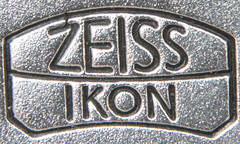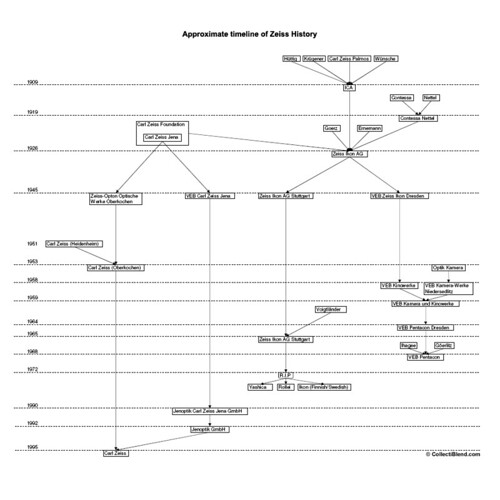Difference between revisions of "Zeiss Ikon"
m (→Links) |
m (→East Germany: VEB Zeiss Ikon Dresden) |
||
| Line 15: | Line 15: | ||
===East Germany: VEB Zeiss Ikon Dresden=== | ===East Germany: VEB Zeiss Ikon Dresden=== | ||
{{Dresden}} | {{Dresden}} | ||
| − | Postwar production began early in May 1945. But it was interrupted because several factories were closed for dismantling their production machines. The machines were given as reparation to the soviet camera makers which had suffered demolition during the war. The production of the sophisticated [[Contax rangefinder]] cameras was prepared in Dresden and relaunched with new machines in Jena before all the machines were transferred to Soviet camera maker [[Kiev]]. In 1948 the East German part of Zeiss Ikon became state owned. Production and development of Ernemann projectors and movie cameras were continued from 1949. Camera production was continued in 1947 with the Tenax and the Ikonta models. Soon the company's stock of [[leaf | + | Postwar production began early in May 1945. But it was interrupted because several factories were closed for dismantling their production machines. The machines were given as reparation to the soviet camera makers which had suffered demolition during the war. The production of the sophisticated [[Contax rangefinder]] cameras was prepared in Dresden and relaunched with new machines in Jena before all the machines were transferred to Soviet camera maker [[Kiev]]. In 1948 the East German part of Zeiss Ikon became state owned. Production and development of Ernemann projectors and movie cameras were continued from 1949. Camera production was continued in 1947 with the Tenax and the Ikonta models. Soon the company's stock of [[leaf shutter]]s was running out. In 1950 it could produce its own shutters since it took over the shutter production of [[Balda]] and the shutter factory of [[Mimosa]]. In 1952 the ''Tempor'' was Zeiss Ikon's first own leaf shutter development, followed in 1954 by the ''Prestor'', the fastest leaf shutter at this time. |
In 1948 the company could introduce its advanced [[SLR]] model, the [[Contax S]]. Since there were suits about trade mark names with the West-German Zeiss Ikon AG, VEB Zeiss Ikon was renamed to '''VEB Kinowerke Dresden''' in 1958. Later it became the main part of the East German combinate [[Pentacon]]. | In 1948 the company could introduce its advanced [[SLR]] model, the [[Contax S]]. Since there were suits about trade mark names with the West-German Zeiss Ikon AG, VEB Zeiss Ikon was renamed to '''VEB Kinowerke Dresden''' in 1958. Later it became the main part of the East German combinate [[Pentacon]]. | ||
Revision as of 20:35, 4 January 2011

|
Zeiss Ikon is a German company that was formed in 1926 by the merger of four camera makers, and indeed the word Ikon came from ICA and Contessa-Nettel, two of the constituents in the merger. The other two companies were Ernemann and Goerz. The company was a part of the Carl Zeiss Foundation, another part being the optical company Carl Zeiss. Logically, most of the Zeiss Ikon cameras were equipped with Carl Zeiss lenses. The merged company was obliged to use Compur shutters for 80% of its cameras. Thus only the simplest cameras could get cheaper shutters like the Klio. Soon AG Hahn für Optik und Mechanik, Kassel, and Goerz Photochemisches Werk GmbH, Berlin, joined the Zeiss Ikon syndicate. The group became one of the big companies in the phototechnical capital Dresden, with plants in Stuttgart and Berlin. Until WWII Zeiss Ikon was the world's market leading maker of 8mm movie cameras.
Contents
West Germany: Zeiss Ikon AG Stuttgart
| Photo industry in Stuttgart |
| Contessa | Contessa-Nettel | Drexler & Nagel | Ebner | Hauff | Kenngott | Kodak AG | G. A. Krauss | Nagel | Zeiss Ikon |
After World War II Zeiss Ikon was split into a West-German and an East-German part. It was reformed in West Germany, and trademark disputes followed with the part that was left in East Germany. Stuttgart became the company's domicile. Zeiss Ikon merged in the mid 1960s with Voigtländer, another important German manufacturer that was controlled by the Zeiss Foundation since 1956. The product lines of Zeiss Ikon Stuttgart were different from the East German company's products. The Ikophot light meters were made in Stuttgart.
Zeiss Ikon ceased the production of cameras in 1972. It was a terrible shock for all the German camera industry. Parts of the Zeiss Ikon product line then went to Rollei, and part of the know-how was used to revive the Contax name in collaboration with the Japanese maker Yashica.
East Germany: VEB Zeiss Ikon Dresden
| Camera industry in Dresden |
| Balda | Certo | Eho-Altissa | Eichapfel | Ernemann | Feinmess | Heyde | Hamaphot | Huth | Hüttig | ICA | Ihagee | Kochmann | Kerman | KW | Eugen Loeber | Ludwig | Mentor | Merkel | Meyer | Mimosa | Pentacon | Richter | Sommer | Stübiger | Unger & Hoffmann | Werner | Wünsche | Zeiss Ikon | Zeh |
| Camera distributors in Dresden |
| Stöckig |
| Camera industry in Freital |
| Beier | Pouva | Stein & Binnewerg | Thowe | Welta |
Postwar production began early in May 1945. But it was interrupted because several factories were closed for dismantling their production machines. The machines were given as reparation to the soviet camera makers which had suffered demolition during the war. The production of the sophisticated Contax rangefinder cameras was prepared in Dresden and relaunched with new machines in Jena before all the machines were transferred to Soviet camera maker Kiev. In 1948 the East German part of Zeiss Ikon became state owned. Production and development of Ernemann projectors and movie cameras were continued from 1949. Camera production was continued in 1947 with the Tenax and the Ikonta models. Soon the company's stock of leaf shutters was running out. In 1950 it could produce its own shutters since it took over the shutter production of Balda and the shutter factory of Mimosa. In 1952 the Tempor was Zeiss Ikon's first own leaf shutter development, followed in 1954 by the Prestor, the fastest leaf shutter at this time.
In 1948 the company could introduce its advanced SLR model, the Contax S. Since there were suits about trade mark names with the West-German Zeiss Ikon AG, VEB Zeiss Ikon was renamed to VEB Kinowerke Dresden in 1958. Later it became the main part of the East German combinate Pentacon.
After German reunification
Today Carl Zeiss is reviving the Zeiss Ikon name. The new Zeiss Ikon camera, introduced at the 2004 Photokina show, is a rangefinder camera compatible with Leica M-mount, developed in Germany and built by Cosina in Japan (with lenses made in both Japan and Germany, like those for the Contax G1 and G2).

|
| Zeiss Ikon History Timeline Image by collectiblend.com |
35mm
Interchangeable Lens Rangefinder
Dresden
Stuttgart
Fixed Lens
- Contessa 35 (later models 1960-1973)
- Contessamatic, Contessamat
- Colora, Colora F
- Contina
- Continette
- Ikonette 35
- Symbolica
- Tenax Automatic
- Tenax I
Folding
- Contina I / II
- Contessa 35 (1950-1955)
- Ikonta 35 [1](Image rights)
- Super Nettel
- Super Nettel II
SLR
- Contaflex I (1953-1958)
- Contaflex II (1954-1959)
- Contaflex III (1956-1958)
- Contaflex IV (1956-1959)
- Contaflex Alpha (1957-1960)
- Contaflex Beta (1957-1958)
- Contaflex Prima (1959-1965)
- Contaflex Rapid (1958-1960)
- Contaflex Super (1959-1963)
- Contaflex Super (new) (1964-1966)
- Contaflex Super B (1962-1965)
- Contaflex Super BC (1965-1968)
- Contaflex S (1968-1971)
- Contaflex 126 (1967-1971)
- Contarex I ("Bullseye" or the "Cyclops")(1959-1966)
- Contarex Professional
- Contarex Super
Together with Voigtländer:
TLR
120 film
Folding
- Bob 510 (alternative name for Nettar 510)
- Nettar
- Nettar II
- Nettax
- Icarette
- Cocarette
- Ikonta
- Super Ikonta A
- Super Ikonta B
- Super Ikonta C
- Super Ikonta III
- Super Ikonta IV
TLR
- Ikoflex Ia (854/16)
- Ikoflex Ib
- Ikoflex Ic (886/16)
- Ikoflex II (851/16)
- Ikoflex IIa
- Ikoflex III
- Ikoflex Favorit
Box
127 film
- Baby Box Tengor
- Ikonette (folding, 127, c.1929)
- Ikonta 3x4 (Baby Ikonta)
- Kolibri
- Piccolette
- V.P. Icarette
Other film
- Nixe A & B
- Baby Cocarette
Plate models
Folding bed
- Maximar A (6.5×9) & B (9×12)
- Ideal 250/3 (6.5×9cm)
- Ideal 250/7 (9×12cm)
- Ideal 250/9 (10×15cm)
- Ideal 250/11 (13×18cm)
- Onito 127/6 (9x12cm)
- Trona (9×12)
- Trix / Orix (10×15)
- Universal Juwel A (9×12) & B (13×18)
- Volta (9×12)
Strut folding
- Nettel
- Miroflex A (6.5×9) & B (9×12)
VEB Zeiss Ikon (Zeiss Ikon East)
35mm SLR
- Contax S
- Contax D or Pentacon
- Contax E or Pentacon E
- Contax F or Pentacon F
- Contax FB or Pentacon FB
- Contax FM or Pentacon FM
- Contax FBM or Pentacon FBM
35mm Fixed Lens
120 folder
- Ercona / Ercona II
Zeiss Ikon / Cosina
- Zeiss Ikon (rangefinder)
- Zeiss Ikon SW (viewfinder)
Light Meters

|
| Ikophot |
- Ikophot
Bibliography
- Barringer, C. and Small, M. Zeiss Compendium East and West. 1940–1972. UK: Hove Books, 2nd edition, 1999. ISBN 1874707243.
- Tubbs, D. B. Zeiss Ikon Cameras. 1926-39. UK: Hove Books, 1993. 190 pages. ISBN 1874707014.
Links
In English:
- Zeiss Super Ikonta Price & Information Guide
- The Zeiss Historica Society
- Zeiss Contax Rangefinder Lens Price & Information Guide
- Zeiss Ikon instruction manuals in butkus.org's Library
- Zeiss Ikon Price Guide at CollectiBlend
In German:
- cameras of Zeiss-Ikon's predecessors at Klaus-Eckard Riess homepage [2]
- Company history at dresdner-kameras.de
- Story of Zeiss Ikon at phototechnik-online.de by Gerd Jehmlich
- Images of Zeiss Ikon cameras at www.amuseum.de
- East German leaf shutters
In French:
- Cameras and user manuals at www.collection-appareils.fr
- Zeiss Ikon page at Collection G. Even's site


